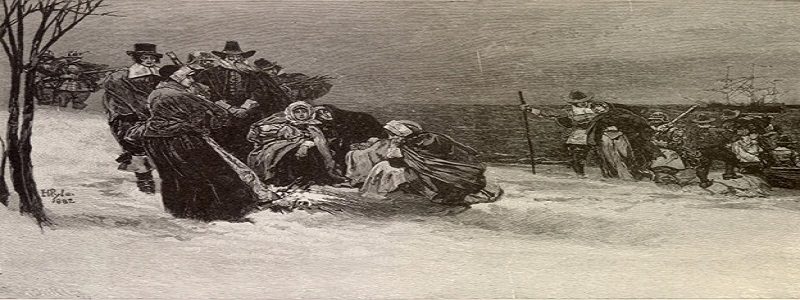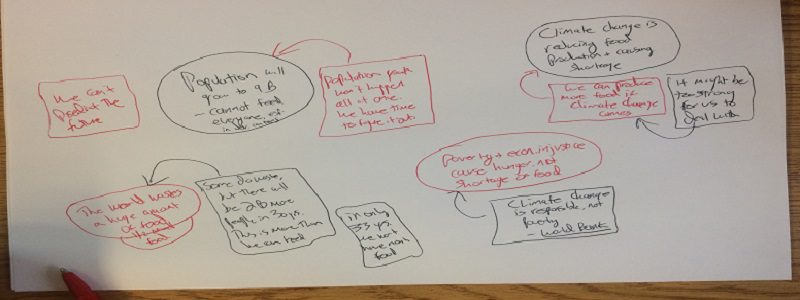Building Them Up, Knocking Them Down: Argument and ‘Elizabeth’s Jamestown Diaries’
Overview
Patricia Hermes’ children’s historical fiction Elizabeth’s Jamestown Colony Diary: The Starving Time, Book 2 (Scholastic Inc., 2001) takes an up-close look at the original Jamestown colony settlement of the English London Company in what is now Virginia, in North America. The work is narrated by a precocious 9 year old girl named Elizabeth. She is drawn as a typical girl, if especially verbal, but she is witness to an extraordinary historical place and time.
The second book of this two-part fictionalized diary account of the Jamestown settlement, The Starving Time is set in 1609 – 1610, and focuses in particular on the awful winter in the middle of this period, during which a colony of nearly 500 people dwindled down, due to hunger and disease, to 60 stalwart survivors.
The Building Them Up, Knocking Them Down project has students assemble arguments from suggested argumentative claims and selected passages on the question over whether Elizabeth loses her essential humanity due to the brutally extreme conditions of that winter. Then it has students participate in Refutation Two-Chance, so that they can respond to counter-arguments from against the arguments they have built on the issue. The project ends with an optional argument writing assessment.
Shaping Arguments: Feedback to Particular Patterns of Student Practice
We have been working with partner middle schools on the argument-based science/social studies project, called Shaping Arguments on Natural Resources. The Debatifier posted on this project recently. We have observed certain patterns of student practice in the implementation of this project, patterns that have elicited some of our feedback “analytics,” which we think may be of interest to the broader educator community using argumentation in the classroom.
The patterns of student practice itemized really do transcend the science/social studies content in this project (on whether the world faces a severe shortage of specific natural resources), and they also transcend the grade levels in which our partner schools have so far implemented it — both because Shaping Arguments on Natural Resources can be readily adjusted for implementation in high school, and because the patterned strengths and weaknesses that students have revealed are common to students across grade levels.
Logical Fallacies: Teaching Reasoning Skills by Examining Their Absence
Many, perhaps most, critical thinking and argumentation textbooks discourage teaching logical fallacies as a stand-alone unit. John Bean, for example, in his Engaging Ideas: A Professor’s Guide to Integrating Writing, Critical Thinking, and Active Learning in the Classroom (John Wiley & Sons, 2011), cautions that students will readily forget the names and definitions of logical fallacies when learned in the abstract, and that they are best learned when blended instruction focused on argumentation about specific content.
I’ve always been persuaded by this position and we recommend it in our work with middle and high school teachers. Acquire a facility with the various types of logical fallacy, and invoke them when most applicable in your regular argument-based instruction. Still, no pedagogical guideline like this should be viewed as an absolute rule, and recently we’ve come across a website that might help teachers elevate the place of logical fallacies in their effort to improve their students’ reasoning skills.
Argument-Based Math Talks
Overview
Math Talks have become a go-to routine for many math teachers in their response to the new wave of math standards that call for a much greater emphasis on requiring students to justify their solutions, to communicate their mathematical reasoning, to make arguments with math, and to think critically about the mathematical reasoning and arguments of others.
Shaping Arguments on Whether We Face a Severe Shortage of Global Natural Resources
Overview
There are 7.5 billion people in the world today. In little more than 10 years, those who study population trends tell us that there will be 8.5 billion people, and a substantially higher percentage of them will be what Americans would identify as “middle class,” with the concomitant demand for natural resources to support their comfortable lifestyle. A dominant environmental problem of our time is climate change, but there are even more long-standing questions over whether the world is running out or has acute shortages of natural resources (such as water, energy, food) that haven’t gone away just because they have been eclipsed in media coverage and American public consciousness by global warming.
This argument-based project focuses on the issue of global shortages of fundamental natural resources for the world’s population, now and in the near future. This project addresses a set of Next Generation Science Standards, the specifics of which depend on the grade level in which it is implemented, along with literacy standards, such as those in the Common Core. It applies the Shaping Arguments format, which we’ve introduced as a format that can be used for highly accessible, non-academic topics as a means of increasing students’ comfort-level with argument language, forms, and practices, but (as this project demonstrates well) can also be used with standard academic content.






